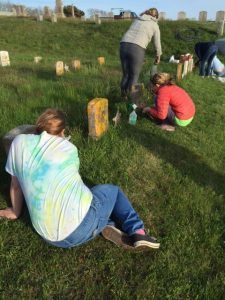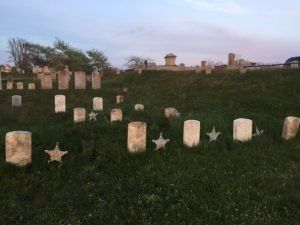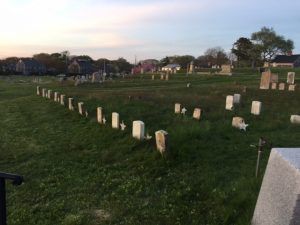Honoring Our Veterans
Work begins.
On May 16, 2017 from 6-8PM, I had the honor of working with Nantucket Girl Scout Troops 80978 and 81174. For over a decade, I have been working to clean the stones of not just the Mitchells, but other Nantucketers buried at Prospect Hill Cemetery with the Prospect Hill Cemetery historian, Paula Levy. She and I first crossed paths when I offered a stone cleaning workshop via the Mitchell House and she was one of the attendees. Since then, we have cleaned roughly twenty or so stones and worked on a restoration project to restore the fences at two family plots, one of them being the Mitchell family plot.
Work continues.
Our work together brought about a discussion of Memorial Day services. The Sons of the American Legion and the island Scouts all come together to put flags and red geraniums at the graves of island veterans. The Memorial Day Parade ends with a service at the Soldiers’ Lot burial site. We thought it would be nice for the Scouts to play a larger role in attending to the veterans and also to provide them with some background on them and a sense of ownership. So, I reached out to some scout leaders and the Girl Scout troops noted above joined in. The Legion provided the funds for the supplies and Paula came and spoke to them briefly about the Soldiers’ Lot and the men buried there. And then, I gave them another brief overview of how to clean – this time hands-on rather than explaining it at a meeting. Then, we got to work – Scouts, Scout leaders, mothers. We managed to clean the stones of all the men interred there – Civil War veterans, WWI veterans, VietNam veterans and more. About eighteen monuments were cleaned of their lichen and mosses and protected from further damage. The stones will lighten some – the point is not to make them pristine or bright white. And the lichen has been removed thus stopping further damage from it. You will note a few that are whiter than others – several are newer stones and others may have been cleaned in the past by others though it looks like they were done with harsh chemicals unfortunately. Remember, never clean stones without permission from the cemetery sexton. DO not clean stones of people other than your family. And most importantly, make sure you have been trained first and have the right tools, specifically a cleaner that is appropriate for the work (bleach is a BIG no-no).
Thank you to the Scout and the Legion, as well as troop leaders and parents!
Work completed.
JNLF
Recent Posts








